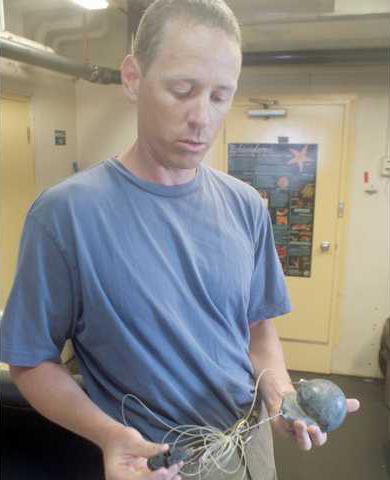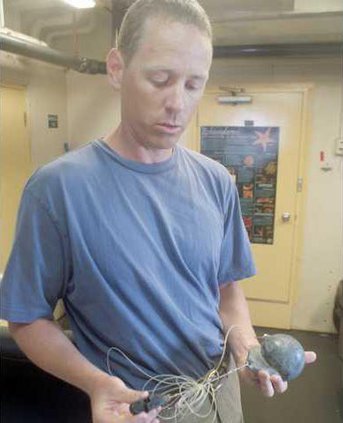According to scientists stationed at Gray’s Reef Marine Sanctuary, there’s no doubt people and their waste affect the delicate 25 mile coral reef that sits 60 feet below the water off the Georgia coast.
“We’ve found some big pieces of debris that the coral has now actually grown over and made a part of it,” said Matt Kendall, a researcher with the National Centers for Coastal Ocean Science.
Concerned about conserving and protecting the reef, researchers aboard the Nancy Foster, a National Oceanic and Atmospheric Administration research vessel they’ve called home for two weeks, were determined to actually quantify the problem through their reef debris collection project.
“What they’re trying to do is determine how much debris is accumulating in the sanctuary. What types of places? Is it high ledges? Is it low ledges? Is it an area where we know people are fishing?” said Sarah Fangman, an associate science coordinator for the NOAA.
The research team is entering its second year of debris collection and Kendall said, unfortunately, the research has shown there is currently a major problem — one bigger than he initially thought.
“To be honest, I didn’t think debris would accumulate that fast,” Kendall said. “I thought it’d be something we’d set up and monitor for five or 10 years and then we’d start seeing debris, but it’s just after a year and already stuff is piling up down there. So it’s more of a problem than I thought.”
Kendall said he has found a wide range of objects clinging to the reef including some things he expected, like fishing debris. However, he’s also found a few odd things like bottles of bleach and a curious elastic waistband leftover from what he’s guessing was a pair of shorts.
Through their collections and observations, Kendall said a pattern is emerging.
“We’ve found there’re two parts to the sanctuary: the Northern middle part with the really tall ledges and that’s where there’s the most boats and fishing so, naturally, that’s where we figured most of the debris would be. We have some collection sites there and we also have some sites in southern part, but there‘s not really any debris there,” Kendall said.
The researchers have a specific method for studying debris when they find it.
“The first thing we do is take a picture at the site and measure the ledge it’s stuck on to try and see if the there’s a relationship between the height and areas of ledges ... and then if we can, we’ll take it off if we can without doing any more damage to the reef.”
Kendall has identified one of the major culprits of serious damage to the reef.
“I think it’s the fishing line that does the most damage when it gets tangled in the reef. When the fishing line gets wrapped around it, it abrades the tissue because coral is a just a thin layer of tissue of a hard skeleton. When you get something tugging on that tissue, it damages the tissue and causes the death of the coral more quickly,” Kendall said.
After finding much more debris than he expected, Kendall now wants to use his research to show people the detrimental side effects of polluting the ocean.
“Showing people the problem is probably one of the most dramatic ways of getting them to stop doing it,” Kendall said.
“We’ve found some big pieces of debris that the coral has now actually grown over and made a part of it,” said Matt Kendall, a researcher with the National Centers for Coastal Ocean Science.
Concerned about conserving and protecting the reef, researchers aboard the Nancy Foster, a National Oceanic and Atmospheric Administration research vessel they’ve called home for two weeks, were determined to actually quantify the problem through their reef debris collection project.
“What they’re trying to do is determine how much debris is accumulating in the sanctuary. What types of places? Is it high ledges? Is it low ledges? Is it an area where we know people are fishing?” said Sarah Fangman, an associate science coordinator for the NOAA.
The research team is entering its second year of debris collection and Kendall said, unfortunately, the research has shown there is currently a major problem — one bigger than he initially thought.
“To be honest, I didn’t think debris would accumulate that fast,” Kendall said. “I thought it’d be something we’d set up and monitor for five or 10 years and then we’d start seeing debris, but it’s just after a year and already stuff is piling up down there. So it’s more of a problem than I thought.”
Kendall said he has found a wide range of objects clinging to the reef including some things he expected, like fishing debris. However, he’s also found a few odd things like bottles of bleach and a curious elastic waistband leftover from what he’s guessing was a pair of shorts.
Through their collections and observations, Kendall said a pattern is emerging.
“We’ve found there’re two parts to the sanctuary: the Northern middle part with the really tall ledges and that’s where there’s the most boats and fishing so, naturally, that’s where we figured most of the debris would be. We have some collection sites there and we also have some sites in southern part, but there‘s not really any debris there,” Kendall said.
The researchers have a specific method for studying debris when they find it.
“The first thing we do is take a picture at the site and measure the ledge it’s stuck on to try and see if the there’s a relationship between the height and areas of ledges ... and then if we can, we’ll take it off if we can without doing any more damage to the reef.”
Kendall has identified one of the major culprits of serious damage to the reef.
“I think it’s the fishing line that does the most damage when it gets tangled in the reef. When the fishing line gets wrapped around it, it abrades the tissue because coral is a just a thin layer of tissue of a hard skeleton. When you get something tugging on that tissue, it damages the tissue and causes the death of the coral more quickly,” Kendall said.
After finding much more debris than he expected, Kendall now wants to use his research to show people the detrimental side effects of polluting the ocean.
“Showing people the problem is probably one of the most dramatic ways of getting them to stop doing it,” Kendall said.

